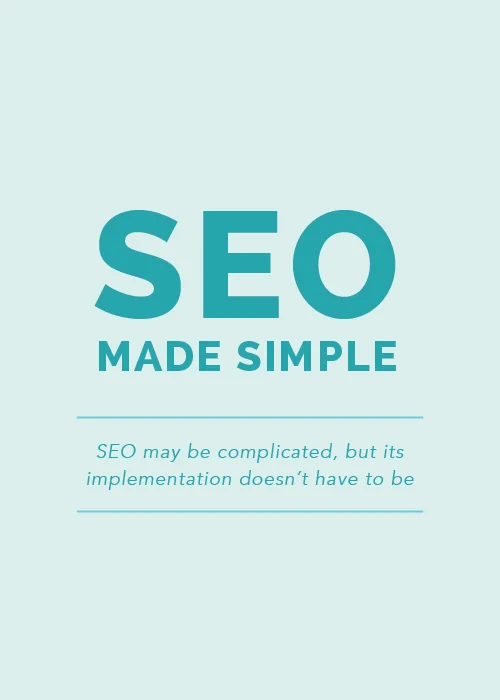SEO is one of those topics that has the potential to make your eyes glaze over.
If you have a blog or a website, you're probably aware that SEO is important for gaining traffic and ranking high in Google searches, but chances are, you might be a little intimidated by it all and unsure of where to start. Jake is my lifesaver when it comes to helping me with Elle & Company's search engine optimization, and today he's sharing the basics to help you get started and improve your SEO, too.
Many people consider SEO a quick fix to their site's dwindling traffic but in reality, SEO is a consistent long-term strategy. 5 years ago you could simply load your website with keywords and add a bunch of back-links and voila! You could have a top Google search ranking. But these days, with the constant advancements and updates to Google's algorithms, it's important to have a good understanding of how Google operates before you invest your time, energy, and money into attempting to boost your SEO.
SEO Defined
There is a lot of misinformation out there about SEO, so it's important to define exactly what that acronym stands for. Search Engine Optimization refers to the strategies and techniques that are used to improve your site's ranking on Google. Each time you enter a subject in Google's search bar and hit Enter, Google crawls and indexes pages to see which websites are the most relevant. Many websites attempt to build in keywords and implement other techniques in order for Google to find their site relevant and give them a high ranking, and this is called SEO.
A higher Google ranking directly relates to more website traffic and only 8.5% of people proceed to the second search page, so it's no wonder that people are concerned with this topic. The implications for getting your website ranked on that first page are huge. The majority of us aren't ranked on that first Google search page, so what can you do to gain traffic to your site while continuing to improve your SEO?
Content > SEO
The single most important aspect of any website is it's content. Content not only brings visitors to your site; it's the central component of your SEO.
Google's goal is to connect individuals with the content they're searching for. Their mission statement highlights this: "The mission of Google is to organize the world's information and make it universally accessible and useful." Google is focused on connecting their users with the most relevant and appropriate content. This means that the most important thing that you can focus on to improve your SEO is to create content that's relevant and appropriate for your readers. If you aren't creating high quality content to attract your ideal audience, no amount of SEO implementation will encourage them to return.
Google stresses content in their SEO starter guide:
"Even though this guide's title contains the words 'search engine,' we'd like to say that you should base your optimization decisions first and foremost on what's best for the visitor's of your site. They're the main consumers of your content and are using search engines to find your work. Focusing too hard on specific tweaks to gain ranking in the organic results of search engines may not deliver the desired results."
Google also says this in their Webmaster Guidelines:
Provide high-quality content on your pages, especially your homepage. This is the single most important thing to do. If your pages contain useful information, their content will attract many visitors and entice webmasters to link to your site. In creating a helpful, information-rich site, write pages that clearly and accurately describe your topic. Think about the words users would type to find your pages and include those words in your site.
Remember you're writing for people, not search engines. People determine whether or not your site has value. That's why the most important aspect of your website is content (Google's words, not mine). Google values quality content over everything else.
Great content generates traffic on its own and organic traffic is best for creating natural back-links, which boosts SEO rankings. This is why Elle & Company stresses creativity when you're thinking through your blog content; confining yourself to the content that everyone else is creating could be costing you traffic. Don't be afraid to be the frontrunner of a new idea or a new way of thinking when it comes to your industry. If you're generating great content that your audience finds helpful, your traffic will increase along with your website's search ranking.
What You Should Do for Your SEO Right Now
Although content is most important, you shouldn't ignore SEO altogether. SEO is a continuous aspect of managing your website. Just like you should consistently create content, you should also be consistently monitoring your SEO. Here are some simple ways to improve your SEO today.
1. Submit Your Content to Google
As the owner of a website, Google allows you to submit your content to increase your visibility in their rankings. To submit your website, click here.
2. Sign into Google Webmaster Tools
Google Webmaster Tools monitors your site's performance in Google searches. Here's Google's description of this tool:
"Webmaster Tools is a free service offered by Google that helps you monitor and maintain your site's presence in Google Search results. You don't have to sign up for Webmaster Tools for your site to be included in Google's search results, but doing so can help you understand how Google views your site and optimize its performance in search results."
If you have a Google account, you already have a Google Webmaster Tools account. Simply visit this link and verify your website.
3. Add Your Sitemap in Google Webmaster Tools
Providing Google with your sitemap allows the search engine to better navigate, index, and crawl your site.
From your home screen, click on your domain name to access your Site Dashboard. In the left-hand panel, click Crawl > Sitemaps. In the right-hand corner of the screen, click Add/Test Sitemap. Squarespace automatically provides sitemaps for their users. If you're a Squarespace user, simply type in sitemap.xml to the box that appears (see example below).
4. Use Fetch as Google to Test How Google is Crawling and Indexing Your Site
This is a way for you to check and make sure that Google can properly crawl your site. Fetch as Google is a "diagnostic tool that allows you to simulate how Google crawls or renders a URL on your site." When you create a new page or section of your website, you're able to type the URL into this tool to ensure that Google is finding it and indexing it properly.
From the Google Webmaster Tools Dashboard, click Crawl > Fetch as Google. Type a page URL into the content bar and click Fetch for a quick check or use Fetch and Render for a more comprehensive look.
Jumping in and exploring is the best way to familiarize yourself with these tools. This post only covers two major aspects of Google Webmaster Tools, but if you would like to learn more, go to the Webmaster Tools Academy and take the course to learn more about this great free tool.
It's important to optimize your site for SEO, but it's most important to pour into your content. Today's post is just the tip of the iceberg; there is much more that you can do with Google Webmaster Tools and SEO. Although this post is the bare bones, our hope is that this will get you headed in the right direction for optimizing your site for Google. Lauren and I have some future SEO posts in the works, but until then, what are your thoughts on the relationship between SEO and content? How do you boost SEO for your site?










